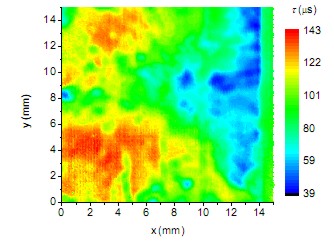Water-based sonochemical cleaning in the manufacturing of high-efficiency photovoltaic silicon wafers
A. Nadtochiy1,
A. Podolian1,
O. Korotchenkov1,
J. Schmid2,
E. Kancsar2,
V. Schlosser2
Faculty of Physics, Taras Shevchenko Kyiv National University, Kyiv 01601, Ukraine
Department of Electronic Properties of Materials, Faculty of Physics, University of Vienna, A-1090 Wien, Austria
Keywords: silicon, sonication, photovoltaic
 ABSTRACT: We found that organic particle contaminants are effectively removed during ultrasonic cleaning in distilled water, as evidenced by the disappearance of organic-related absorption peaks and remarkable shortening of the surface photovoltage decay transients (SPV). SPV decay transient mappings obtained with a 100-μm spatial resolution (see abstract figure) show that, in multicrystalline Si wafers, the resulting effect on the decay time is markedly non-uniform compared with that observed in crystalline Si, implying the existence of a mechanism associated with the grain boundaries. The data are tentatively interpreted in terms of the wafer hydrogenization, which most probably occur through the grain boundaries. It is assumed that elevated temperatures inside a cavitating bubble may lead to water and bubble gas decomposition, accompanied by a subsequent trapping of the decomposed particulates at the silicon surface. These particulates can then be predominantly incorporated into the grain boundary regions. We suggest that this can be in part due to hydrogen molecules decomposed in water which are mobile in silicon.
ABSTRACT: We found that organic particle contaminants are effectively removed during ultrasonic cleaning in distilled water, as evidenced by the disappearance of organic-related absorption peaks and remarkable shortening of the surface photovoltage decay transients (SPV). SPV decay transient mappings obtained with a 100-μm spatial resolution (see abstract figure) show that, in multicrystalline Si wafers, the resulting effect on the decay time is markedly non-uniform compared with that observed in crystalline Si, implying the existence of a mechanism associated with the grain boundaries. The data are tentatively interpreted in terms of the wafer hydrogenization, which most probably occur through the grain boundaries. It is assumed that elevated temperatures inside a cavitating bubble may lead to water and bubble gas decomposition, accompanied by a subsequent trapping of the decomposed particulates at the silicon surface. These particulates can then be predominantly incorporated into the grain boundary regions. We suggest that this can be in part due to hydrogen molecules decomposed in water which are mobile in silicon.
 ABSTRACT: We found that organic particle contaminants are effectively removed during ultrasonic cleaning in distilled water, as evidenced by the disappearance of organic-related absorption peaks and remarkable shortening of the surface photovoltage decay transients (SPV). SPV decay transient mappings obtained with a 100-μm spatial resolution (see abstract figure) show that, in multicrystalline Si wafers, the resulting effect on the decay time is markedly non-uniform compared with that observed in crystalline Si, implying the existence of a mechanism associated with the grain boundaries. The data are tentatively interpreted in terms of the wafer hydrogenization, which most probably occur through the grain boundaries. It is assumed that elevated temperatures inside a cavitating bubble may lead to water and bubble gas decomposition, accompanied by a subsequent trapping of the decomposed particulates at the silicon surface. These particulates can then be predominantly incorporated into the grain boundary regions. We suggest that this can be in part due to hydrogen molecules decomposed in water which are mobile in silicon.
ABSTRACT: We found that organic particle contaminants are effectively removed during ultrasonic cleaning in distilled water, as evidenced by the disappearance of organic-related absorption peaks and remarkable shortening of the surface photovoltage decay transients (SPV). SPV decay transient mappings obtained with a 100-μm spatial resolution (see abstract figure) show that, in multicrystalline Si wafers, the resulting effect on the decay time is markedly non-uniform compared with that observed in crystalline Si, implying the existence of a mechanism associated with the grain boundaries. The data are tentatively interpreted in terms of the wafer hydrogenization, which most probably occur through the grain boundaries. It is assumed that elevated temperatures inside a cavitating bubble may lead to water and bubble gas decomposition, accompanied by a subsequent trapping of the decomposed particulates at the silicon surface. These particulates can then be predominantly incorporated into the grain boundary regions. We suggest that this can be in part due to hydrogen molecules decomposed in water which are mobile in silicon.